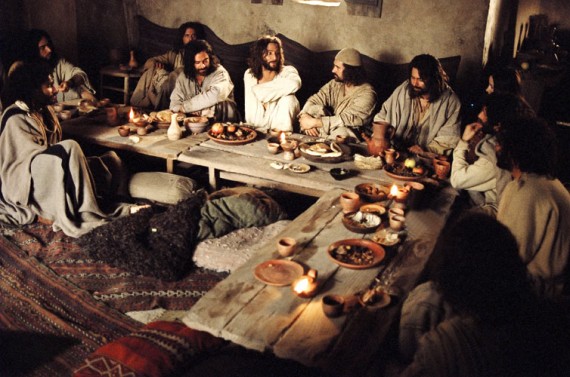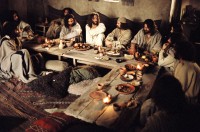John 17 records the prayer that Jesus prayed in the Upper Room with His disciples at the conclusion of their last supper together. By looking at this prayer, we can learn how to pray like Jesus.
Though the Gospels frequently record Jesus going off by Himself to pray, this is the only recorded prayer of Jesus of any length which provides an indication of the sort of things Jesus might have said when He prayed.
What can we learn from this prayer of Jesus about how to pray?

The Structure of the Prayer
Scholars have long noted that the prayer is divided into three basic sections.
First, Jesus prays for Himself (John 17:1-5), then for His disciples (John 17:6-19), and finally for all who would believe in Him (John 17:20-26). Much can be said about the content of Jesus’ prayer, especially that the primary prayer request of Jesus for all who would believe in Him is that we would be unified (John 17:21).
But my purpose here is not to analyze and explain the prayer of Jesus as much as it is to simply look at how Jesus prayed.
The Posture of the Prayer of Jesus
Notice first the posture of Jesus.
The text does not tell us if Jesus was sitting, standing, or reclining (though reclining on the floor was the typical way of eating meals and conversing afterwards in first century Middle Eastern culture).
One thing is for sure though: Jesus definitely was not bowing folding His hands, bowing His head, and closing His eyes. To the contrary, the text says He “lifted up His eyes to heaven” (John 17:1), which indicates that His eyes were open and His head was raised.
Nevertheless, this is not the “God-approved” posture of prayer. It is not as if such things as kneeling or standing, arms up or arms down, eyes open or eyes closed make any difference in whether or not God hears and answers our prayers. If God is concerned about any sort of posture in our prayers, it is the posture of our hearts, which no one can see but Him alone.
The Prayer Requests of Jesus
What else can we learn from the prayer of Jesus about how to pray?
Well, notice that Jesus begins by praying for Himself. How often have we been told in sermons and books on prayer that we must not begin with ourselves, but instead, begin with adoration of God, and thanksgiving for what He has done?
I have not only heard sermons like this; I have preached sermons about this!
Yet the first thing Jesus does is pray for Himself.
But notice what He prays about for Himself. The primary prayer of Jesus for Himself is that He would glorify the Father. So really, this first prayer request is not exactly about Jesus, but about glorifying God the Father. This is a great thing to pray for yourself, because brining glory to God the father is one of the primary reasons we are here on earth.
Of course, Jesus does spend the entire prayer just praying for Himself … as some of us are guilty of doing (myself included!). Instead, He spends most of His time praying for others.
I think most of us are familiar with the concept of praying for other people, and so I will not belabor the point, other than to say that the primary prayer requests of Jesus for others is that they would remain faithful to God, and in unity with one another. I don’t think God minds hearing prayers for Aunt Mabel’s bunion, our neighbor’s dog, and how the rent is overdue, especially when these are issues that really do concern us. But I do believe that it would be wise for all Christians to develop a broader vision for prayer than how we can use it to tell God about our aches and pains and bills.
How Jesus Does Not Pray
Notice also what is not in this prayer of Jesus.
Nowhere is the needless repetition of the name of God. Nowhere is any attempt to ward off the devil. Nowhere is any flowery and fancy language to impress those who present with His advanced holiness.
In fact, there is almost nothing that sets this prayer apart from any other conversation Jesus has with any of His disciples elsewhere in the Gospels. His conversation with God sounds pretty much just like a conversation He might have with Peter, or Matthew, or John.
For Jesus, communicating with God was just like communicating with others. No special language was needed.
Conversational Prayer
And this brings us to what I think is the main thing we can learn from the prayer of Jesus in John 17.
As I read this prayer, it almost sounds as if the prayer is a small part of a much longer conversation He has been having with God for a very long time. As such, Jesus does not appear to have the need to fit everything in, follow a prayer outline, use any special language, remember any prayer requests, or even begin and end the prayer with a flowery introduction and conclusion.
He simply transitions from talking to His disciples to talking to God. One second He is looking at His disciples and speaking with them, and then next He is looking at God and speaking with Him. His tone and language and posture and even the content of what He is saying does not really change. For Jesus, prayer is just continuing a conversation with God.

When understood this way, prayer become much less of a mystery about how to pray and what to pray for and who can pray and where to pray, and much more like a conversation we have in everyday life.
If you can talk with a friend, you can talk to God. That is how Jesus prayed, and how we can pray too. I write a lot more about this in my book, What is Prayer?
Do you want to pray like never before?
Do you what to talk to God like you talk to a friend? Do you want to see more answers to prayer?
If you have these (and other) questions about prayer, let me send you some teaching and instruction about prayer to your email inbox. You will receive one or two per week, absolutely free. Fill out the form below to get started.

Thanks for visiting this page ... but this page is for Discipleship Group members.
If you are already part of a Faith, Hope, or Love Discipleship Group,
Login here.
If you are part of the free "Grace" Discipleship group, you will need to
Upgrade your Membership to one of the paid groups.
If you are not part of any group, you may learn about the various groups and their benefits here:
Join Us Today.





Jeremy,
I must concur with what you have written here, unfortunately I too, am guilty of preaching the same way in the past.
The way you have broken it down should give folks a sense of new freedom in their relationship and conversation with Father.
Another excellent piece!
Thanks David. Prayer is one of those things it is dangerous to teach or write on, because as soon as you do, it changes on you.
That’s why I am a little hesitant to write these posts, but, we’re all learning from each other anyway…
Simply yes. This is what my prayer is like now. It confuses people in the group setting sometimes who are not used to the less formal approach. I think of the Pharisee and the Tax Collector whose prayers Jesus commented on in Luke 18. One was flowery and formal and pretty much directed to the audience, the other plain honest to God…
I think to deeper the relationship grows, the less formal the conversation becomes…kind of like other relationships. 😉
Katherine,
Absolutely.
Does anybody every say anything about your prayers being too informal?
Not so far, but until the last few months, I haven’t been in a group prayer setting (except with a close friend who prays the same way) for years…
This is a great series on prayer, Jeremy.
This is a great series on prayer, Jeremy. First the Disciple’s Prayer, and now his priestly prayer. Scripture “meat” to chew on.
Thank you Jackie.
Some of these ideas will also find their way over to Scripture-on.com as well, once I start writing on prayer over there.
A servant heart will always focus on others. How to pray was told by Jesus through the prayer we call the lords prayer. Prayer is about a conversation with God. Some might call our words of adoration, supplication, tongues and singing as prayers, I myself would call it worship, but does it really matter how I communicate with God. There will be times when I’m walking, cycling or traveling by car or public transport that I think about Dad or my Bro or me mate the Holy Spirit without saying anything.
I keep saying and will continue to say that His Blood has given me total freedom to approach Him, any time, any where. He also allows me to have my eyes open or closed, He allows me to kneel or stand, I am even allowed to put my hands together, wow, how about that then.
Jesus never gave us a formula, He was more interested that we had two way communication directly with God, thats what the blood did, it ripped the 4 inch thick curtain from top to bottom to give us that direct access without all the pageantry and paraphernalia which is all to do with the law and absolutely nothing to do with Love.
Clive
Clive,
Excellent points. Jesus did not give us a formula, and just as in any relationship, how we communicate changes as the relationship changes, so our communication with God changes as we grow closer to Him, and sometimes struggle with life, or even what He is doing in our lives.
Bible is a great way for children to learn about God and you have shared very informative post for this. With the help of your article, kids can easily know the purpose of Bible study.